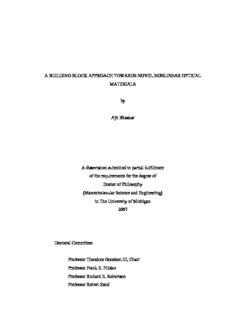
(nm) A PDF
Preview (nm) A
A BUILDING BLOCK APPROACH TOWARDS NOVEL NONLINEAR OPTICAL MATERIALS by Ajit Bhaskar A dissertation submitted in partial fulfillment of the requirements for the degree of Doctor of Philosophy (Macromolecular Science and Engineering) in The University of Michigan 2007 Doctoral Committee: Professor Theodore Goodson III, Chair Professor Frank E. Filisko Professor Richard E. Robertson Professor Robert Zand Dedication, Determination, and Inspiration. The three most important things needed for a PhD and these are where I got them from. © Ajit Bhaskar 2007 Dedication I dedicate this dissertation to my parents for their unwavering support and encouragement. ii Acknowledgements First of all, I would like to express my sincere gratitude to my advisor Professor Goodson. Not only did he introduce me to the fascinating world of ultrafast spectroscopy but also provided me with an extremely healthy and synergistic working environment. His constant motivation and encouragement enabled me to raise everyday and look forward going to work with a smile on my face. I also consider him as a mentor and I would look up to him as a role model if I choose to become a faculty member in the future. I would like to thank the members on my dissertation committee Professor Frank Filisko, Professor Richard Robertson and Professor Robert Zand for their valuable discussions and suggestions. I would also like to thank Professor Goodson’s group members, particularly Dr Ramakrishna Guda, Dr Oleg Varnavski, Dr Ying Wang and Dr Xingzhong Yan for patiently teaching me the details of various spectroscopic tools in our lab. I would like to thank the other postdoctoral scholars and graduate students of Professor Goodson’s group who have also been an integral part of making the lab a fun place to work. Undergraduate and high school students like Unique Luna and Adam Ross have provided me with the opportunity to mentor and impart my knowledge to them. I would like to thank them for the opportunity. My work would not be possible without the synthetic capabilities of Professor Robert Twieg at Kent State University, Professor Michael Haley at The University of Oregon, Professor Peter Bauerle at The University of Ulm, Professor Masahiko Iyoda at Tokyo Metropolitan University and Professor Kazuya Ogawa at Nara Institute of Science iii and Technology. I would like to sincerely thank them for providing me with the opportunity to apply my skills and knowledge on their materials. I would also like to thank the Macromolecular Science and Engineering program, particularly Nonna Hamilton and the Macro graduate students for making my stay in Ann Arbor an extremely pleasant and memorable one. Last, but never least, I would like to thank my family for their invaluable support. Without them, I wouldn’t be where I am today. iv Table of Contents Dedication...........................................................................................................................ii Acknowledgements............................................................................................................iii List of Figures....................................................................................................................ix List of Tables..................................................................................................................xvii Abstract..........................................................................................................................xviii Chapter 1 Introduction and Background.............................................................................1 1.1. Nonlinear Optics and Nonlinear Optical Materials............................................1 1.2. Two-Photon Absorption......................................................................................5 1.2.1. Background.................................................................................................6 1.2.2. Theoretical Considerations.......................................................................16 1.2.3. Excitations in Conjugated Aggregates......................................................20 1.2.4. Structure-Function Relationships for Developing Organic Materials for TPA 23 1.3. Overview of Subsequent Chapters....................................................................29 1.4. References.........................................................................................................33 Chapter 2 Experimental Techniques.................................................................................39 2.1. Lasers: The Choice of Light Source for Studying NLO Processes..................39 2.1.1. Properties of Laser Light..........................................................................40 2.2. Generation of Fast Pulses..................................................................................41 2.3. Experimental Methods for Determination of TPA Cross Sections...................47 2.3.1. Two-Photon Excited Fluorescence Method..............................................48 2.3.2. Nonlinear Transmission (NLT).................................................................50 2.3.3. Z-Scan.......................................................................................................51 2.3.4. Non-Degenerate Pump Probe Method13...................................................53 2.4. Techniques for Investigating Excited State and Fluorescence Dynamics........54 2.4.1. Fluorescence Lifetime Measurements......................................................54 v 2.4.2. Ultrafast Transient Absorption Spectroscopy...........................................57 2.4.3. Fluorescence Upconversion......................................................................62 2.5. Reference..........................................................................................................67 Chapter 3 Rigid, Symmetric, Two-Dimensional Graphidyne Networks..........................69 3.1. Introduction.......................................................................................................69 3.2. Experimental.....................................................................................................71 3.2.1. Optical Absorption and Emission Measurements.....................................72 3.2.2. Fluorescence Quantum Yield Measurements...........................................72 3.2.3. Two Photon Absorption Cross Section Measurements............................74 3.2.4. Transient Absorption Measurements........................................................74 3.3. Results and Discussion.....................................................................................75 3.3.1. Optical Absorption and Steady State Fluorescence Measurements..........75 3.3.2. TPA Cross Section Measurements............................................................78 3.3.3. Ultrafast Transient Absorption Measurements.........................................93 3.4. Conclusions.....................................................................................................100 3.5. References.......................................................................................................102 Chapter 4 Investigation of Two-Photon Absorption Properties in Branched Architectures ........................................................................................................................................104 4.1. Overview.........................................................................................................104 4.2. Structure-Property Relationships in Novel Alkene and Alkyne Branched Chromophores.............................................................................................................105 4.2.1. Background.............................................................................................105 4.2.2. Experimental Details...............................................................................108 4.2.3. Results and Discussion...........................................................................112 4.2.4. Factors Influencing TPA Cross Sections and Rationale.........................122 4.3. Ultrafast Excited State Relaxation Dynamics of a Branched Donor-π-Acceptor Chromophore: Evidence of Charge Delocalized State...............................................125 4.3.1. Background.............................................................................................125 4.3.2. Experimental...........................................................................................127 4.3.3. Results and Discussion...........................................................................129 vi 4.4. Oligothiophene Dendrimers as Novel Materials for Nonlinear Optical Applications................................................................................................................140 4.4.1. Introduction.............................................................................................140 4.4.2. Experimental...........................................................................................143 4.4.3. Results and Discussion...........................................................................145 4.5. Conclusions.....................................................................................................152 4.6. References.......................................................................................................155 Chapter 5 Investigation of Enhancement of Two-Photon Absorption Cross Section in Macrocyclic Thiophenes.................................................................................................164 5.1. Introduction.....................................................................................................164 5.2. Two-Photon Absorption Behavior of Macrocycles Containing Short Thiophene and Alkyne Segments.................................................................................................166 5.2.1. Background.............................................................................................166 5.2.2. Experimental Details...............................................................................169 5.2.3. Results and Discussion...........................................................................171 5.3. TPA Enhancement in Thiophene Macrocycles Consisting of Alternating Thiophene and Alkyne Segments...............................................................................186 5.3.1. Background.............................................................................................186 5.3.2. Experimental Details...............................................................................188 5.3.3. Results and Discussion...........................................................................189 5.4. Conclusions.....................................................................................................195 5.5. References.......................................................................................................198 Chapter 6 Nonlinear Optical Properties of Giant Porphyrin Macrocycles.....................201 6.1. Introduction.....................................................................................................201 6.2. Experimental Section......................................................................................204 6.2.1. Materials.................................................................................................204 6.2.2. Steady State Measurements....................................................................205 6.2.3. Two-Photon Absorption Measurements.................................................207 6.2.4. Ultrafast Transient Absorption Measurements.......................................208 6.3. Results and Discussion...................................................................................208 6.3.1. Steady State Measurements....................................................................208 vii 6.3.2. Two Photon Absorption Measurements..................................................210 6.3.3. Ultrafast Transient Absorption...............................................................211 6.4. Conclusions.....................................................................................................213 6.5. Reference........................................................................................................215 Chapter 7 Zinc Ion Sensing via Enhancement of Two-Photon Excited Fluorescence...220 7.1. Introduction.....................................................................................................220 7.2. Experimental...................................................................................................221 7.2.1. Synthesis of Chromophores....................................................................221 7.2.2. Steady state measurements.....................................................................222 7.2.3. Two-Photon Absorption Cross Section measurements...........................222 7.2.4. Ultrafast Transient Absorption Measurements.......................................223 7.3. Results and Discussion...................................................................................223 7.3.1. Steady Stateand TPA measurements.....................................................223 7.3.2. Transient Absorption Measurements......................................................238 7.4. Conclusions.....................................................................................................251 7.5. Reference........................................................................................................253 Chapter 8 Overall Summary and Outlook......................................................................255 8.1. Summary.........................................................................................................255 8.2. Outlook...........................................................................................................259 viii
Description: